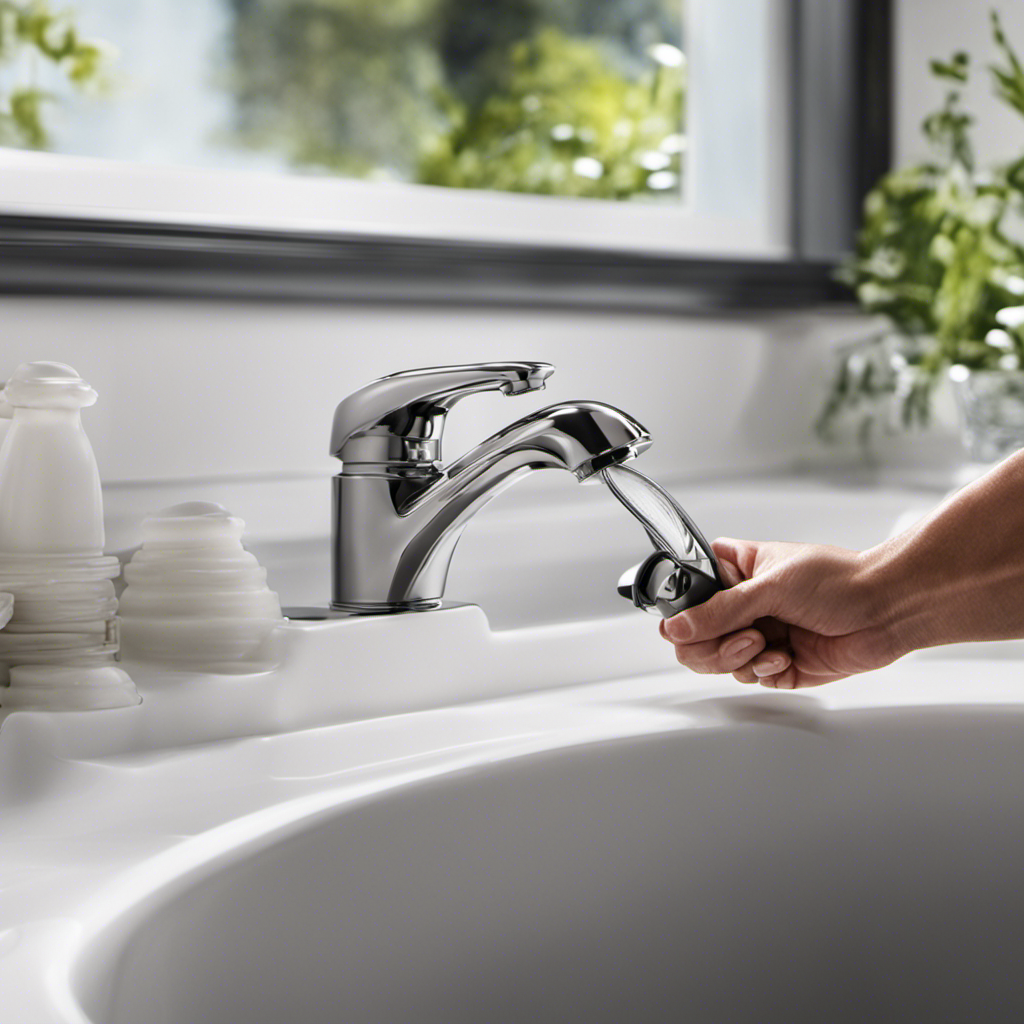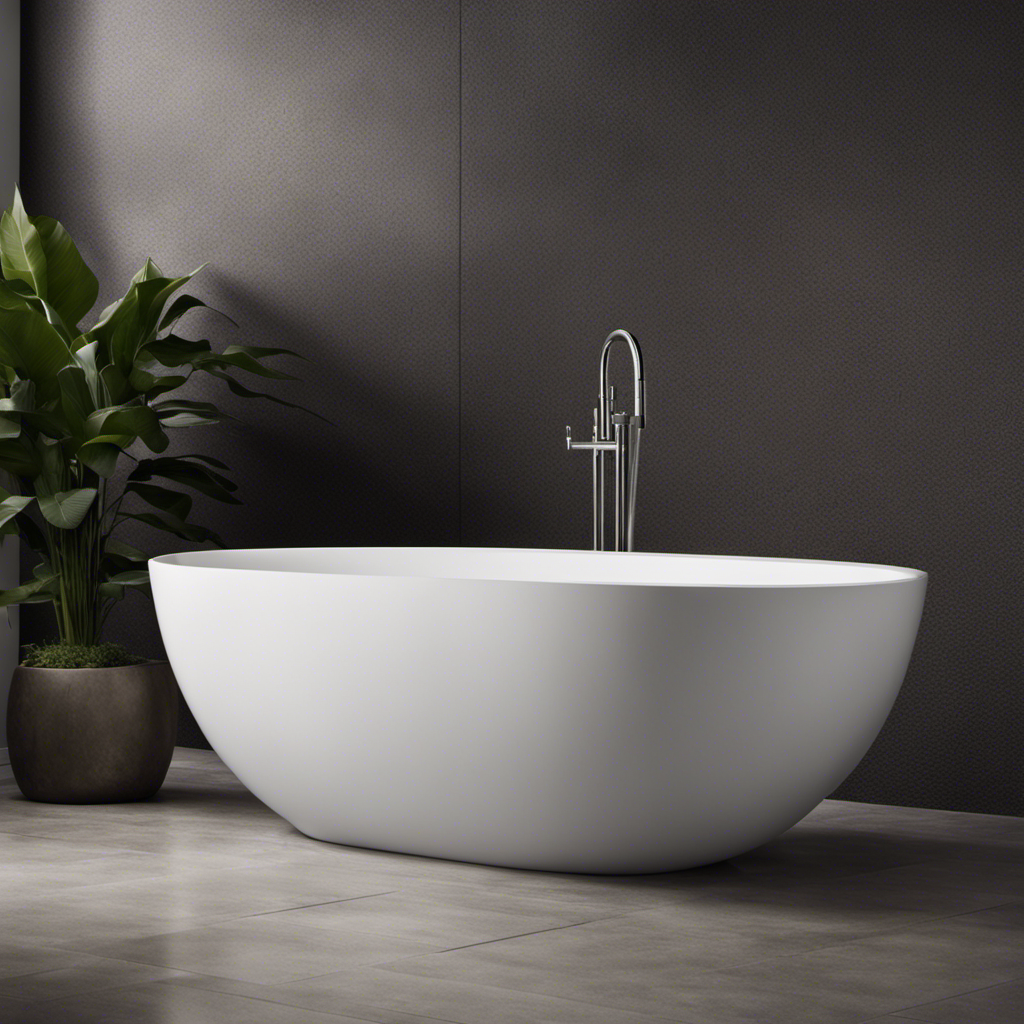Are you tired of looking at your worn-out bathtub? It’s time to transform it into a sparkling new centerpiece of your bathroom.
In this article, we’ll show you how to paint your bathtub with ease. From choosing the right paint to preparing the surface and applying the perfect finish, we’ve got you covered.
Say goodbye to expensive replacements and hello to a rejuvenated bathtub that will make you proud.
Let’s dive in and make your bathtub shine again!
Key Takeaways
- Choose a paint specifically designed for bathtubs that can withstand water, chemicals, and cleaning agents and provides a protective barrier against moisture.
- Thoroughly clean the bathtub surface with a mild cleaner and scrub brush, and sand it using fine-grit sandpaper to create a rough texture and remove any glossy finish.
- Remove old paint or coating using a chemical paint remover designed for bathtubs, and repair any chips or cracks using a bathtub repair kit or a combination of filler and epoxy resin.
- Apply a primer before painting to enhance adhesion and prevent peeling and chipping, and select the best paint application method for your skill level, such as spray gun or sponge application.
Choosing the Right Paint for Your Bathtub
Before you start painting your bathtub, make sure you’re using the right type of paint.
Choosing the right bathtub paint is crucial for achieving a durable and long-lasting finish.
When it comes to durability, it’s important to opt for a paint specifically designed for bathtubs. These paints are formulated to withstand frequent exposure to water, chemicals, and cleaning agents without peeling or chipping. Additionally, they provide a protective barrier against moisture, preventing the growth of mold and mildew.
When it comes to color options, bathtub paints come in a wide range of shades to suit your taste and bathroom decor. From classic white to bold and vibrant colors, you can find the perfect paint to transform your bathtub into a focal point of your bathroom.
Preparing the Bathtub Surface for Painting
First, you’ll need to thoroughly clean and sand the surface to ensure proper adhesion. Preparing the surface is crucial for a successful bathtub painting project.
Start by removing any dirt, grime, or soap scum using a mild cleaner and a scrub brush. Rinse the bathtub thoroughly and allow it to dry completely.
Next, sand the surface using fine-grit sandpaper to create a rough texture that will help the paint adhere better. Make sure to sand evenly and remove any glossy finish.
After sanding, wipe down the surface with a damp cloth to remove any dust particles. This step is essential to achieve a smooth and long-lasting finish.
Removing Old Paint or Coating From the Bathtub
To remove old paint or coating from the tub, you’ll need to use a chemical stripper or a heat gun. Here’s how you can effectively remove stubborn paint stains using chemical paint removers:
-
Choose the right chemical stripper: Look for a chemical paint remover specifically designed for bathtub surfaces. Ensure it’s safe to use on the material of your tub.
-
Prepare the area: Open windows or use a fan for proper ventilation. Cover the surrounding areas with a drop cloth or plastic sheet to protect them from any spills or drips.
-
Apply the chemical stripper: Follow the instructions provided on the product. Apply the stripper generously to the painted surface using a brush or roller. Let it sit for the specified amount of time to allow the chemical to penetrate the paint.
-
Scrape off the paint: Use a paint scraper or putty knife to gently scrape off the softened paint. Be careful not to damage the tub surface.
-
Repeat if necessary: If there are any remaining paint stains, repeat the process until the tub surface is completely free of paint.
-
Clean the tub: Once all the paint is removed, clean the tub thoroughly with water and a mild detergent to remove any residue from the chemical stripper.
Repairing Chips or Cracks in the Bathtub
When it comes to repairing chips or cracks in your bathtub, there are a few key points to keep in mind.
First, for filling small cracks, you’ll want to use a bathtub repair kit that includes epoxy or acrylic filler.
Second, if you have a larger chip, you’ll need to patch it with a combination of filler and epoxy resin.
Filling Small Cracks
If you’re looking to paint the bathtub, make sure to fill any small cracks before starting. Repairing small cracks in your bathtub is an important step to ensure a smooth and flawless finish. Here’s what you need to know about filling hairline cracks:
-
Clean the cracks: Use a mild abrasive cleaner and a scrub brush to clean the cracks thoroughly. This will remove any dirt, grime, or soap residue that may prevent the filler from adhering properly.
-
Choose the right filler: Look for a bathtub repair kit that contains a waterproof epoxy or acrylic filler. These fillers are specifically designed to withstand water and provide a durable repair.
-
Apply the filler: Using a putty knife, apply the filler to the cracks, making sure to fill them completely. Smooth out the surface with the putty knife, and let it dry according to the manufacturer’s instructions.
Patching Larger Chip
Now that you know how to fill small cracks in your bathtub, let’s move on to patching larger chips. When your bathtub has deep scratches or large chips, it’s important to repair them properly before painting. Here’s a step-by-step guide to help you with this process:
| Materials Needed | Steps |
|---|---|
| Epoxy filler | 1. Clean the damaged area with a mild detergent and rinse thoroughly. |
| Putty knife | 2. Mix the epoxy filler according to the manufacturer’s instructions. |
| Sandpaper | 3. Apply the filler to the damaged area using a putty knife, making sure to fill it completely. |
| Primer | 4. Allow the filler to dry completely, then sand it down until it’s smooth and level with the surrounding surface. |
Sanding and Smoothing
To achieve a smooth and even surface, use sandpaper to gently sand and smooth out the repaired area. Sanding is an important step in surface preparation before painting your bathtub. Here are some tips to help you achieve the best results:
- Start with a lower grit sandpaper, such as 120 or 150, to remove any roughness or unevenness from the patched area.
- Gradually move up to a higher grit sandpaper, like 220 or 320, to refine the surface and create a smooth finish.
- Use sanding tools like sanding blocks or sanding sponges to ensure even pressure and consistent results.
Sanding will help the new paint adhere better and create a seamless look. Remember to clean the surface thoroughly after sanding to remove any dust or debris before proceeding with the painting process.
Cleaning and Sanding the Bathtub Surface
First, make sure you thoroughly clean and sand the bathtub surface before painting. Cleaning and sanding are crucial steps that ensure a smooth and long-lasting finish. To clean the surface, use a mild detergent or a specialized bathtub cleaner to remove any dirt, grime, or soap residue. Rinse thoroughly and dry the surface completely. When it comes to sanding techniques, you can use sandpaper or a sanding block to gently roughen the surface, creating a better adhesion for the paint. Start with a coarse-grit sandpaper and gradually move to a finer grit for a smoother finish. Remember to wear a dust mask and eye protection during this process. Here is a table to help you understand the different cleaning products and sanding techniques:
| Cleaning Products | Sanding Techniques |
|---|---|
| Mild detergent | Sandpaper |
| Bathtub cleaner | Sanding block |
Applying Primer to the Bathtub
When it comes to painting your bathtub, using a primer is essential for a smooth and long-lasting finish. Primer provides a variety of benefits, such as enhancing adhesion, preventing peeling and chipping, and ensuring better coverage of the topcoat.
There are different types of bathtub primers available, including epoxy-based primers, acrylic primers, and water-based primers, each with their own unique properties and suitability for different bathtub materials.
To apply primer correctly, make sure to clean and dry the surface thoroughly, apply thin and even coats, and allow sufficient drying time between coats for optimal results.
Benefits of Using Primer
Using primer before painting your bathtub helps to ensure better adhesion and longer-lasting results. It is essential to understand the advantages and importance of using primer in this process.
Here are three reasons why using primer is beneficial:
-
Improved Adhesion: Primer creates a smooth surface for the paint to adhere to, preventing peeling or flaking over time.
-
Enhanced Durability: By providing a protective layer, primer helps to withstand daily wear and tear, ensuring your newly painted bathtub stays looking fresh for longer.
-
Even Color Application: Primer helps to even out the surface, reducing the appearance of brush strokes or uneven color distribution.
Applying primer before painting your bathtub is a crucial step that should not be overlooked. It not only enhances the final result but also ensures the longevity of your bathtub’s new look.
Types of Bathtub Primers
One type of primer that is commonly used on tubs is an epoxy-based primer. This type of primer is specifically formulated to adhere to the smooth and non-porous surface of a bathtub, ensuring excellent adhesion for the paint that will be applied later.
There are several reputable bathtub primer brands available in the market, such as Rust-Oleum, Zinsser, and KILZ. Using a primer before painting your bathtub offers numerous benefits. It helps to create a smooth and even surface, improves paint durability, enhances color vibrancy, and prevents peeling or chipping.
Applying primer correctly is crucial for achieving the desired results. Now that you are familiar with the types of bathtub primers, let’s move on to the next step: applying primer correctly.
Applying Primer Correctly
To achieve the best results, make sure you apply the primer correctly before painting your tub. Applying primer is an important step in the bathtub painting process as it helps the paint adhere better and ensures a smooth and long-lasting finish.
Here are some tips for applying primer:
-
Clean the surface: Before applying primer, make sure the bathtub is clean and free from any dirt, grease, or soap residue. Use a mild cleaner and scrub the surface gently to remove any impurities.
-
Choose the right primer: There are different types of primers available for different surfaces. Make sure you choose a primer specifically designed for bathtubs to ensure proper adhesion and durability.
-
Apply in thin, even coats: When applying primer, it’s important to apply it in thin, even coats. This will help prevent drips and ensure a smooth finish. Allow each coat to dry completely before applying the next.
Selecting the Best Paint Application Method
When painting the bathtub, you’ll want to consider the best paint application method. Two popular options are spray gun application and sponge application.
If you’re looking for a quick and efficient way to paint your bathtub, using a spray gun is your best bet. The spray gun allows for an even and smooth application of paint, ensuring a professional finish.
On the other hand, if you prefer a more hands-on approach, sponge application may be the right choice for you. This method involves using a sponge to apply the paint in even strokes, providing a textured finish.
Whether you opt for the convenience of a spray gun or the control of sponge application, make sure to choose the method that suits your preferences and skill level.
Painting the Bathtub With a Brush or Roller
When it comes to painting a bathtub, the choice between using a brush or a roller is an important one. Each method has its own advantages and techniques that can help you achieve the best results.
In this discussion, we will explore the key differences between using a brush and a roller, as well as provide you with useful painting techniques and tips to ensure a successful bathtub transformation.
Brush Vs. Roller
Using a roller will give you a smoother finish on the bathtub compared to using a brush. The brush technique may leave streaks or brush marks on the surface, while a roller ensures a more even and professional-looking result. When it comes to durability, rollers are designed to withstand the rigors of painting, making them a reliable choice for this project.
Here are some advantages of using a roller for painting your bathtub:
- Efficiency: A roller covers a larger area more quickly than a brush.
- Even coverage: The roller distributes the paint evenly, ensuring a consistent color and texture.
- Smooth finish: The nap of the roller helps to eliminate brush strokes, leaving a smooth and flawless surface.
Now that you understand the benefits of using a roller, let’s move on to explore some painting techniques and tips for achieving the best results on your bathtub.
Painting Techniques and Tips
To achieve the best results, you’ll want to start by prepping the surface of your tub. Before you begin painting, gather all the necessary painting supplies like a high-quality primer, epoxy paint specifically designed for bathtubs, a paintbrush, and a roller.
When it comes to color selection, choose a shade that complements your bathroom decor and personal style. Keep in mind that lighter colors tend to make the space look bigger and brighter, while darker hues can create a cozy, intimate atmosphere.
Once you have your supplies and color chosen, it’s time to move on to the next step: spraying the bathtub with paint.
Spraying the Bathtub With Paint
I’ll show you how to spray the bathtub with paint for a smooth and even finish. When it comes to painting the bathtub, using a sprayer can be a great option. Here are some spraying techniques to consider:
- Start with proper preparation: Clean the bathtub thoroughly and remove any old paint or residue.
- Use a high-quality paint sprayer: Invest in a good sprayer that allows for adjustable pressure and provides an even spray pattern.
- Practice proper technique: Hold the sprayer about 6-8 inches away from the surface and move it in a steady back-and-forth motion.
Spraying the bathtub has its pros and cons. On one hand, it provides a smooth and professional-looking finish. On the other hand, it can be messy and requires more preparation and cleanup. However, with the right techniques and equipment, spraying can be a time-saving and efficient method for painting your bathtub.
Now that you’ve learned about spraying techniques and its pros and cons, let’s move on to the next step: curing and drying time for painted bathtub.
Curing and Drying Time for Painted Bathtub
Now that you have successfully sprayed the bathtub with paint, it’s important to understand the curing and drying time for the painted surface. The curing time refers to the period in which the paint fully hardens and reaches its maximum durability. On the other hand, the drying process is the time it takes for the paint to dry to the touch.
To give you a better understanding of the curing and drying time, here is a table outlining the typical time frames for different types of paint:
| Type of Paint | Curing Time | Drying Time |
|---|---|---|
| Acrylic Enamel | 48-72 hours | 4-6 hours |
| Epoxy Paint | 7 days | 12-24 hours |
| Urethane Paint | 7-10 days | 24-48 hours |
It’s essential to follow the manufacturer’s instructions for the specific paint you used, as curing and drying times can vary. During this period, avoid using the bathtub or exposing it to excessive moisture to ensure the paint fully cures and provides a long-lasting finish.
Maintaining and Cleaning a Painted Bathtub
Regular cleaning and gentle maintenance are essential for preserving the longevity and appearance of your newly painted tub. To keep your painted bathtub looking its best, follow these tips:
-
Use non-abrasive cleaning products: Harsh chemicals and abrasive cleaners can damage the paint on your tub. Instead, opt for mild, non-abrasive cleaners specifically designed for painted surfaces.
-
Avoid scrubbing vigorously: While it’s important to clean your tub regularly, avoid scrubbing too hard as this can cause the paint to chip or peel. Instead, use a soft sponge or cloth to gently clean the surface.
-
Rinse thoroughly: After cleaning, be sure to rinse your tub thoroughly with warm water. This will help remove any residue and prevent build-up that can dull the appearance of the paint.
Frequently Asked Questions
Can I Use Regular Paint for My Bathtub or Do I Need a Specific Type of Paint?
You’ll need a specific type of paint for your bathtub, not just regular paint. Regular paint won’t hold up to the constant exposure to water and cleaning products. Look for a bathtub refinishing paint that is designed for this purpose.
How Can I Remove Stubborn Stains From the Bathtub Surface Before Painting?
To remove stubborn stains from your bathtub surface before painting, start by using a mixture of vinegar and baking soda. Scrub the stains gently with a brush, and watch them vanish like magic!
Is It Necessary to Remove All the Old Paint or Coating From the Bathtub Before Applying a New One?
To achieve the best results, it is necessary to remove all the old paint or coating from the bathtub before applying a new one. This step is crucial in the preparation process.
What Should I Do if There Are Deep Chips or Cracks in the Bathtub Surface?
If you have deep chips or cracks in your bathtub surface, it’s important to repair them before painting. Fill the cracks with a bathtub repair kit and use a filler to fix the chips. Sand and smooth the repairs before applying the new paint.
How Often Do I Need to Clean and Maintain a Painted Bathtub?
To keep your painted bathtub in top shape, regular cleaning and maintenance are essential. This ensures longevity and prevents the need for frequent repainting. Experience the benefits of a well-maintained tub.
Conclusion
So there you have it, a simple and effective guide on how to paint your bathtub.
By following these steps, you can transform your old and worn-out bathtub into a fresh and beautiful centerpiece in your bathroom.
While some may argue that painting a bathtub is a difficult and time-consuming task, the satisfaction and pride you’ll feel after completing this project will make it all worth it.
So don’t let any doubts hold you back, grab your paintbrush and get ready to give your bathtub a stunning makeover.










